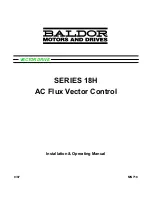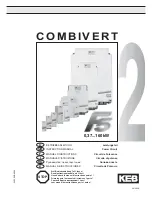
L200 Inverter
Getting Star
ted
1–13
Torque and Constant Volts/Hertz Operation
In the past, AC variable speed drives used an
open loop (scalar) technique to control speed.
The constant-volts-per-hertz operation
maintains a constant ratio between the applied
voltage and the applied frequency. With these
conditions, AC induction motors inherently
delivered constant torque across the operating
speed range. For some applications, this scalar
technique was adequate.
Today, with the advent of sophisticated micro-
processors and digital signal processors (DSPs),
it is possible to control the speed and torque of AC induction motors with unprecedented
accuracy. The L200 utilizes these devices to perform complex mathematical calculations
required to achieve superior performance. You can choose various torque curves to fit
the needs of your application. Constant torque applies the same torque level across the
frequency (speed) range. Variable torque, also called reduced torque, lowers the torque
delivered at mid-level frequencies. A torque boost setting will add additional torque in
the lower half of the frequency range for the constant and variable torque curves. With
the free-setting torque curve feature, you can specify a series of data points that will
define a custom torque curve to fit your application.
Inverter Input and Three-Phase Power
The Hitachi L200 Series of inverters includes two sub-groups: the 200V class and the
400V class inverters. The drives described in this manual may be used in either the
United States or Europe, although the exact voltage level for commercial power may be
slightly different from country to country. Accordingly, a 200V class inverter requires
(nominal) 200 to 240VAC, and a 400V class inverter requires from 380 to 480VAC.
Some 200V class inverters will accept single-phase or three-phase power, but all 400V
class inverters require a three-phase power supply.
TIP: If your application only has single phase power available, refer to L200 inverters of
3HP or less; they can accept single phase input power.
The common terminology for single phase power is Line (L) and Neutral (N). Three-
phase power connections are usually labeled Line 1 [R/L1], Line 2 [S/L2] and
Line 3 [T/L3]. In any case, the power source should include an earth ground connection.
That ground connection will need to connect to the inverter chassis and to the motor
frame (see
“Wire the Inverter Output to Motor” on page 2–20
Output frequency
Output
voltage
V
100%
0
Constant torque
f
Содержание L200 Series
Страница 2: ......
Страница 40: ......
Страница 186: ......
Страница 187: ...Inverter System Accessories In This Chapter page Introduction 2 Component Descriptions 3 Dynamic Braking 5 5 ...
Страница 192: ......
Страница 209: ...Glossary and Bibliography In This Appendix page Glossary 2 Bibliography 8 A ...
Страница 256: ......
Страница 257: ...Drive Parameter Settings Tables In This Appendix page Introduction 2 Parameter Settings for Keypad Entry 2 C ...
Страница 268: ......
Страница 269: ...CE EMC Installation Guidelines In This Appendix page CE EMC Installation Guidelines 2 Hitachi EMC Recommendations 6 D ...
Страница 273: ...L200 Inverter Appendix D D 5 L1 L2 L3 PE L200 inverter with book type filter M 3 ...
















































